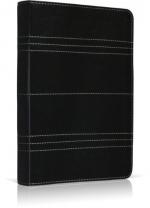|
This section contains 397 words (approx. 2 pages at 300 words per page) |
Graphite is a soft, black, metallic mineral composed of the element carbon. It is nontoxic and rubs off easily on rough surfaces, which is why graphite mixed with fine clay, rather than actual lead, is used to make pencil leads. The word graphite derives from the Greek gréphein, to write or draw.
Graphite has the same chemical formula as diamond (C), yet the two minerals could hardly be more unlike. Diamond is the hardest of minerals, graphite one of the softest; diamond is transparent, graphite opaque; and diamond is almost twice as dense as graphite. These radically different properties arise from the way the atoms are arranged in each substance. In graphite, carbon atoms are linked in hexagonal sheets resembling chicken-wire fencing. These sheets slide over each other easily, which accounts for graphite's slipperiness. In diamond, carbon atoms are linked in a potentially endless matrix of tetrahedra (four-cornered pyramids), an extremely strong arrangement. Surprisingly, however, graphite is stable under ordinary atmospheric conditions and diamond is not; that is, at standard temperature and pressure diamond transforms spontaneously to graphite. The rate of transformation is extremely slow because carbon atoms organized into diamond are separated from the lower-energy graphite state by an activation-energy barrier similar to that which keeps an explosive from going off until triggered by a spark.
The carbon in most graphite and diamonds derives from living things. The organic (carbon-containing) remains of organisms may be transformed into coal or into impurities in limestone; under some conditions, metamorphosis of these rocks purifies these organic materials to produce graphite. Further metamorphosis under extremely high pressures, such as occur many miles underground, is needed to produce diamond.
Because graphite is resistant to heat and slows neutrons, it was used in the early years of nuclear-power research as a matrix to contain radioactive fuel elements and moderate their chain reaction. Early atomic reactors were termed atomic piles because they consisted mostly of large piles of graphite blocks. Graphite is used not only in pencils, but also as a lubricant for locksmiths and for bearings operating in vacuum or at high temperatures. Because it is both conductive and slippery, graphite is used in generator brushes. It is also employed in making metallurgical crucibles and electrical batteries. Most of the graphite used is manufactured from coal in electrical furnaces, not mined.
See Also
|
This section contains 397 words (approx. 2 pages at 300 words per page) |


